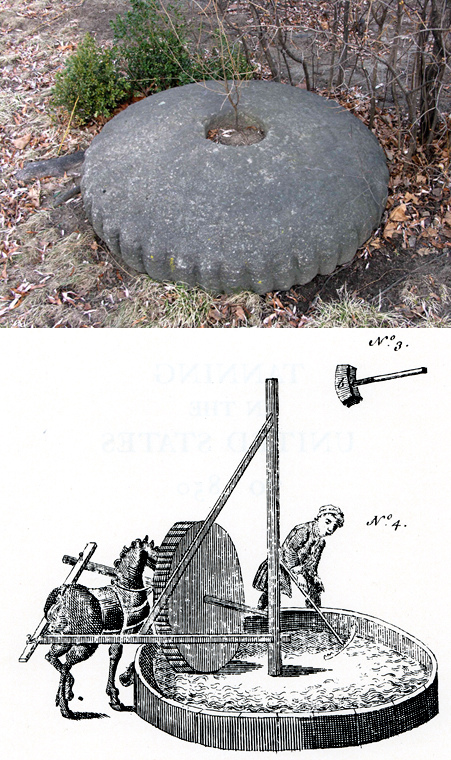Dorchester Illustration of the Day no. 1594
Bark-Crushing Stone
This large stone was used to crush bark for use in the tanning industry. Settlers who arrived in the Massachusetts Bay Colony as part of the Great Migration would have brought knowledge of the tanning process with them. Tanning went hand in hand with livestock farming and agriculture. Herds of livestock that could not be kept overwinter were slaughtered in the autumn, and every piece of the animal was used for meat, leather, gelatin, glue, plaster, fertilizer. The clearing of forests for the preparation of planting fields yielded lumber for building houses, barns and fences as well as tree bark that was used for its tannin content.
Although most plants contain some tannin, tree bark has a concentration large enough to be useful for tanning operations. Crushed oak, willow, beech, sumac, chestnut, cedar or hemlock bark was laid in the bottom of the pit, then a layer of hides, and more bark, layering alternately, finishing with a thick layer of bark. The tanner tamped down the pile as he filled the pit. Then he kept the whole moist for a period of about three months. The hides became soft and subject to tearing so the tanner needed to take care when unpacking the hides. The action of the chemicals in the pit was stopped by applying a dressing of alkaline materials that included soft soap, boiled meal and dung from dogs, pigs or birds
As early as the 1640s there is a reference in the Aspinwall Notarial Records to John Glover of Dorchester who was engaged in tanning. William Bodwell in the Boston Sunday Herald in 1901 said: Dorchester, too, was noted for its tanneries, and the pioneer in the business was a John Glover, a very appropriate name for a light leather dresser, and a gentleman who was, according to some authorities, the first to set up tanning in the Massachusetts plantation (colony). Whether this was the first official business of tanning, other families must have tanned leather as part of their own household and farming operations. Later, there are references to the Humphreys family, the Clap family, and others who built tanning companies.
Various members of the Clap/Clapp family went into the business of tanning. Hepzibah Clap described her father Ebenezer (1771-1860): “When about twenty-five he hired six tan pits of Captain Samuel Holden, and began to work for himself. The mill-house stood on the South of Trull Street. In long days, he did his work in the morning and went out mowing by the day. … In 1798 (Sept 4), I came into life. The next spring he began his tanyard on the banks of Royal Pond, near his Father’s home. The bark for the business was then ground by a large stone carried round by a horse.”
Ebenezer seems to have had an experimental nature—he tried out various types of bark grinding methods, evidenced by a license he acquired to use the Tobey mill (more like a big coffee grinder) and by his daughter Hepzibah’s comment that he later tried wind power for this purpose.
“… The making of pits was very expensive. He could afford but a few at a time, but after many years had a large tanyard. In 1816 he built a new mill house and had a windmill put up to grind bark; but it did not answer the purpose; when it was high wind going with a velocity that was frightful; It was a great expense and disappointment.”
Lemuel Clap was a tanner on the properties handed down by the original Clap settlers on the west side of Boston Street. The Claps were industrious, and like many other families, pursued businesses ancillary to their farming operations. The seventeenth-century members of the family constructed and operated a tidal grist-mill at the edge of the South Bay. Tanning was therefore the second business carried on by the family, and tanning later yielded to horticulture. Lemuel’s son William used the profits from tanning to build his 1806 Federal-style house at 195 Boston Street, and his sons devoted their lives to the agricultural side of the family operations, developing new varieties of pears. They also carried on an importing business of fine leathers for the Boston market.
______
The Dorchester Illustration of the Day (DIOTD) is sent weekdays. If you receive this e-mail by mistake, please reply to be taken off the e-mail list. If you know others who would like to receive the daily e-mail, please encourage them to join the group by going to http://groups.google.com/group/dorchester-historical-society. You may contact Earl Taylor at ERMMWWT@aol.com
If you value receiving the DIOTD, please express your appreciation by making a donation to the Dorchester Historical Society, either by regular mail at 195 Boston Street, Dorchester, MA 02125, or through the website at www.DorchesterHistoricalSociety.org

